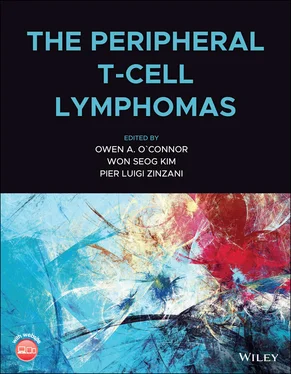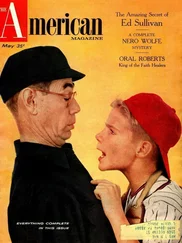51 51 de Mel, S., Soon, S.G., Mok, Y. et al. (2018). The genomics and molecular biology of natural killer/T‐cell lymphoma: opportunities for translation. Int J Mol Sci 19 (7): 1931.
52 52 O’Connor, O.A., Falchi, L., Lue, J.K. et al. (2019). Oral 5‐azacytidine and romidepsin exhibit marked activity in patients with PTCL: a multicenter phase 1 study. Blood 134 (17): 1395–1405.
53 53 Yi, S., Sun, J., Qiu, L. et al. (2018). Dual role of EZH2 in cutaneous anaplastic large cell lymphoma: promoting tumor cell survival and regulating tumor microenvironment. J Invest Dermatol 138 (5): 1126–1136.
54 54 Fernandez‐Pol, S., Ma, L., Joshi, R.P., and Arber, D.A. (2019). A survey of somatic mutations in 41 genes in a cohort of T‐cell lymphomas identifies frequent mutations in genes involved in epigenetic modification. Appl Immunohistochem Mol Morphol 27 (6): 416–422.
55 55 Ng, S.Y., Brown, L., Stevenson, K. et al. (2018). RhoA G17V is sufficient to induce autoimmunity and promotes T‐cell lymphomagenesis in mice. Blood 132 (9): 935–947.
56 56 Cortes, J.R., Ambesi‐Impiombato, A., Couronné, L. et al. (2018). RHOA G17V induces T follicular helper cell specification and promotes Lymphomagenesis. Cancer Cell 33 (2): 259–273.e7.
57 57 Yoo, H.Y., Sung, M.K., Lee, S.H. et al. (2014). A recurrent inactivating mutation in RHOA GTPase in angioimmunoblastic T cell lymphoma. Nat Genet 46 (4): 371–375.
58 58 Sakata‐Yanagimoto, M., Nakamoto‐Matsubara, R., Komori, D. et al. (2017). Detection of the circulating tumor DNAs in angioimmunoblastic T‐cell lymphoma. Ann Hematol 96 (9): 1471–1475.
59 59 Pizzi, M., Margolskee, E., and Inghirami, G. (2018). Pathogenesis of peripheral T cell lymphoma. Annu Rev Pathol 13 (1): 293–320.
60 60 Iqbal, J., Amador, C., McKeithan, T.W., and Chan, W.C. (2019). Molecular and genomic landscape of peripheral T‐cell lymphoma. In: T‐Cell and NK‐Cell Lymphomas: From Biology to Novel Therapies (eds. C. Querfeld, J. Zain and S.T. Rosen), 31–68. Cham: Springer International Publishing.
61 61 Dunleavy, K., Wilson, W.H., and Jaffe, E.S. (2007). Angioimmunoblastic T cell lymphoma: pathobiological insights and clinical implications. Curr Opin Hematol 14 (4): 348–353.
62 62 Gaulard, P. and de Leval, L. (2011). Follicular helper T cells: implications in neoplastic hematopathology. Semin Diagn Pathol 28 (3): 202–213.
63 63 Zhou, Y., Attygalle, A.D., Chuang, S.S. et al. (2007). Angioimmunoblastic T‐cell lymphoma: histological progression associates with EBV and HHV6B viral load. Br J Haematol 138 (1): 44–53.
64 64 Nelson, M., Horsman, D.E., Weisenburger, D.D. et al. (2008). Cytogenetic abnormalities and clinical correlations in peripheral T‐cell lymphoma. Br J Haematol 141 (4): 461–469.
65 65 Fernández‐Piqueras, J. (2016). New mutations for nodal lymphomas of TFH origin. Blood 128 (11): 1446–1447.
66 66 Yoo, H.Y., Kim, P., Kim, W.S. et al. (2016). Frequent CTLA4‐CD28 gene fusion in diverse types of T‐cell lymphoma. Haematologica 101 (6): 757–763.
67 67 Attygalle, A., Feldman, A., and Dogan, A. (2013). ITK/SYK translocation in angioimmunoblastic T‐cell lymphoma. Am J Surg Pathol 37: 1456–1457.
68 68 Zain, J.M. (2019). Aggressive T‐cell lymphomas: 2019 updates on diagnosis, risk stratification, and management. Am J Hematol 94 (8): 929–946.
69 69 Yabe, M., Dogan, A., Horwitz, S.M., and Moskowitz, A.J. (2019). Angioimmunoblastic T‐cell lymphoma. In: T‐Cell and NK‐Cell Lymphomas: From Biology to Novel Therapies (eds. C. Querfeld, J. Zain and S.T. Rosen), 99–126. Cham: Springer International Publishing.
70 70 O’Connor, O.A., Horwitz, S., Masszi, T. et al. (2015). Belinostat in patients with relapsed or refractory peripheral T‐cell lymphoma: results of the pivotal phase II BELIEF (CLN‐19) study. J Clin Oncol 33 (23): 2492–2499.
71 71 Coiffier, B., Pro, B., Prince, H.M. et al. (2014). Romidepsin for the treatment of relapsed/refractory peripheral T‐cell lymphoma: pivotal study update demonstrates durable responses. J Hematol Oncol 7: –11.
72 72 Delarue, R., Dupuis, J., Sujobert, P. et al. (2016). Treatment with hypomethylating agent 5‐azacytidine induces sustained response in angioimmunoblastic T cell lymphomas. Blood 128 (22): 4164.
73 73 Savage, K.J., Harris, N.L., Vose, J.M. et al. (2008). ALK− anaplastic large‐cell lymphoma is clinically and immunophenotypically different from both ALK+ ALCL and peripheral T‐cell lymphoma, not otherwise specified: report from the international peripheral T‐cell lymphoma project. Blood 111 (12): 5496–5504.
74 74 Shustov, A. and Soma, L. Anaplastic large cell lymphoma: contemporary concepts and optimal management. In: T‐Cell and NK‐Cell Lymphomas: From Biology to Novel Therapies (eds. C. Querfeld, J. Zain and S.T. Rosen), 127–144. Cham: Springer International Publishing.
75 75 Fujikawa, D., Nakagawa, S., Hori, M. et al. (2016). Polycomb‐dependent epigenetic landscape in adult T‐cell leukemia. Blood 127 (14): 1790–1802.
76 76 Swerdlow, S.H., Campo, E., Pileri, S.A. et al. (2016). The 2016 revision of the World Health Organization classification of lymphoid neoplasms. Blood 127 (20): 2375–2390.
77 77 Pfister, S.X., Ahrabi, S., Zalmas, L.P. et al. (2014). SETD2‐dependent histone H3K36 trimethylation is required for homologous recombination repair and genome stability. Cell Rep 7 (6): 2006–2018.
78 78 Küçük, C., Jiang, B., Hu, X. et al. (2015). Activating mutations of STAT5B and STAT3 in lymphomas derived from γδ‐T or NK cells. Nat Commun 6 (1): 6025.
79 79 Vaqué, J., Gómez‐López, G., Monsálvez, V. et al. (2014). PLCG1 mutations in cutaneous T‐cell lymphomas. Blood 123 (13): 2034–2043.
80 80 Woollard, W.J., Pullabhatla, V., Lorenc, A. et al. (2016). Candidate driver genes involved in genome maintenance and DNA repair in Sézary syndrome. Blood 127 (26): 3387–3397.
81 81 van Doorn, R., Slieker, R.C., Boonk, S.E. et al. (2016). Epigenomic analysis of Sézary syndrome defines patterns of aberrant DNA methylation and identifies diagnostic markers. J Invest Dermatol 136 (9): 1876–1884.
82 82 Cancer Genome Atlas Research Network, Weinstein, J.N., Collisson, E.A. et al. (2013). The Cancer Genome Atlas Pan‐Cancer analysis project. Nat Genet 45 (10): 1113–1120.
83 83 Chihara, D. and Oki, Y. NK‐cell lymphomas. In: T‐Cell and NK‐Cell Lymphomas: From Biology to Novel Therapies (eds. C. Querfeld, J. Zain and S.T. Rosen), 163–184. Cham: Springer International Publishing.
84 84 Kiel, M.J., Sahasrabuddhe, A.A., Rolland, D.C.M. et al. (2015). Genomic analyses reveal recurrent mutations in epigenetic modifiers and the JAK–STAT pathway in Sézary syndrome. Nat Commun 6 (1): 8470.
85 85 Ungewickell, A., Bhaduri, A., Rios, E. et al. (2015). Genomic analysis of mycosis fungoides and Sézary syndrome identifies recurrent alterations in TNFR2. Nat Genet 47 (9): 1056–1060.
86 86 Michel, L., Jean‐Louis, F., and Begue, E. (2013). Use of PLS3, Twist, CD158k/KIR3DL2, and NKp46 gene expression combination for reliable Sézary syndrome diagnosis. Blood 121 (8): 1477–1478.
87 87 Jones, C.L., Ferreira, S., McKenzie, R.C.T. et al. (2012). Regulation of T‐plastin expression by promoter hypomethylation in primary cutaneous T‐cell lymphoma. J Invest Dermatol 132 (8): 2042–2049.
88 88 Coiffier, B., Pro, B., Prince, H.M. et al. (2012). Results from a pivotal, open‐label, phase II study of romidepsin in relapsed or refractory peripheral T‐cell lymphoma after prior systemic therapy. J Clin Oncol 30 (6): 631–636.
89 89 Olsen, E.A., Kim, Y.H., Kuzel, T.M. et al. (2007). Phase IIb multicenter trial of vorinostat in patients with persistent, progressive, or treatment refractory cutaneous T‐cell lymphoma. J Clin Oncol 25 (21): 3109–3115.
Читать дальше












